When diagnosing gout, doctors recommend that patients change their diet first, along with medication. Diet is an essential part of a comprehensive treatment for gout. Its use will speed up recovery as much as possible, quickly relieve pain symptoms, reduce the severity of seizures and prolong remission periods.
Dietary principles and benefits
The main goal of diet therapy is to organize a diet that will help fight pathology and prevent relapses. The gout diet focuses on:
- regulation of purine metabolism;
- depletion of urate;
- normalization of the process of removal of excess uric acid;
- regulation of metabolic processes;
- increased urinary alkalinity;
- weight loss in case of overweight;
- the general health of the patient.
Hypopurine diets are based on therapeutic principles and dietary regimen rules, including banning foods high in purines, salts and oxalic acids. It is also necessary to reduce the amount of fat, carbohydrate and protein compounds consumed.
Therapeutic diet and diet for gout involves increasing the proportion of vegetables, fruits, natural drinks, kefir, cottage cheese in the diet. The most effective is a 4-5 one-time proper diet with an average caloric content in the range of 2, 500 to 2, 800 units.
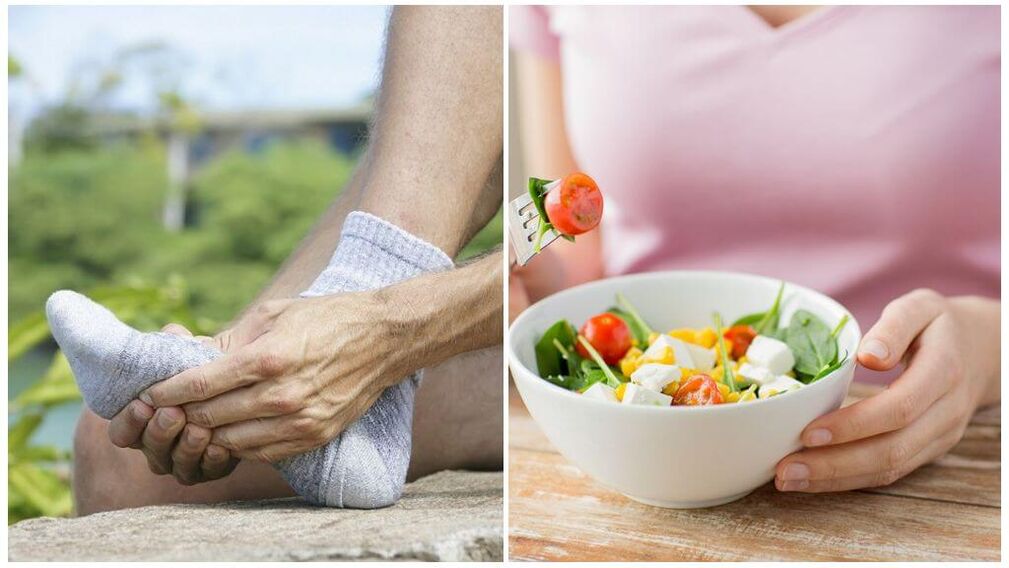
Important!
The drinking regimen should allow 2 to 5 liters or more of fluid to enter the body.
How to organize meals
To increase the effectiveness of your gout diet, you need to follow a number of recommendations:
- the main type of cooking is cooking, baking, steaming;
- after cooking for 10 minutes, drain the meat broth;
- alternative meat, fish and vegetarian dishes;
- use only natural liquids;
- spend fasting days;
- avoid fasting.
Important!
In the presence of chronic diseases, it is necessary to contact a specialist to develop an individual nutritional system.
The main types of diets
Organizing a proper therapeutic diet will not completely prevent gout, but it will significantly alleviate the pathology and prevent its recurrence. The type of diet prescribed will largely depend on the patient's general condition, weight, the presence of additional diseases, and even gender.
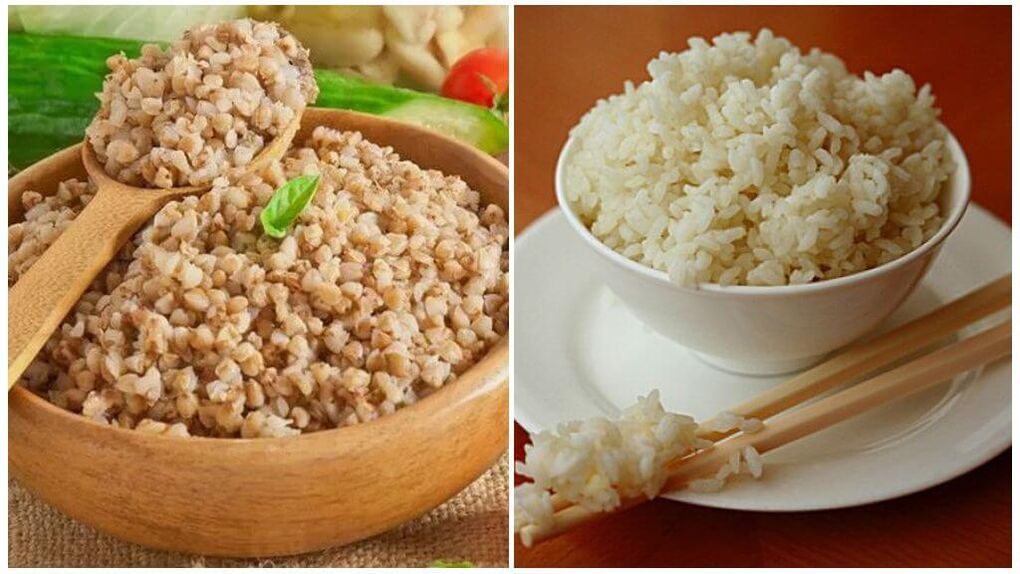
The main medical diet for gout is diet number 6. In addition, patients with gout, especially those suffering from shortness of breath and overweight, often use diet table number 8, alkaline, rice and buckwheat diets. Kefir, cottage cheese, fruit or vegetable diets are good for fasting days.
Diet table number 6
First, it is for patients with gout. This allows to normalize the exchange of purine compounds in a short time and to eliminate the causes of crystallization and accumulation of uric acid salts.
Nutritional compliance reduces the activity of uric acid reactions in the body. As a result, the patient's well-being improves quickly, the inflammatory process stops growing, the swelling is reduced, the feeling of pain and stiffness in the joints disappears.
Diet for high uric acid levels
It is based on the refusal or reduction of products with a high purine, refractory fat, salt index.
It is proposed to replace them with products with an alkaline effect: dairy products, sour milk, cottage cheese, fruits and vegetables. The diet provides for one fasting day a week.
Diet in case of exacerbation of gout
First, during exacerbation it is necessary to increase the amount of fluid consumed to 3 liters. Then completely exclude dishes with meat and fish. Animal protein deficiency can be filled by increasing the proportion of dairy and sour milk products in the diet.
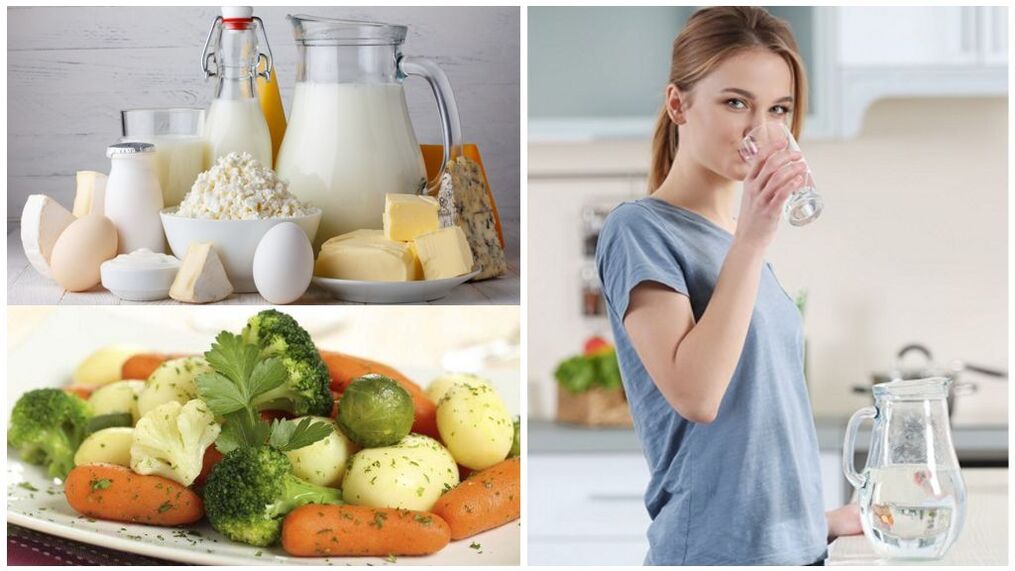
Before the end of the acute period of the disease, fasting days should be arranged every other day, eating the same type of food (cottage cheese, kefir, boiled vegetables, fruit).
Important!
Fasting causes rapid excretion of uric acid and is strictly prohibited in gout.
Diet table number 8
Table no. 8 is a strictly regulated diet for gouty feet in overweight patients. The purpose of this diet is to increase metabolism and get rid of excess fat in the body.
The main difference from the general requirements of a therapeutic diet for gout in this case is a moderate reduction in caloric content and intake of drinking fluid, an average of up to 1. 5 liters per day.
On a note!
For men with gout, the diet is designed to keep the caloric content of the food at a level of not less than 2100-2500 units. For women with gout, diet number 8 limits the menu from 1400 to 1700 kcal.
Buckwheat diet
The low calorie content of buckwheat allows them to be used in a therapeutic diet. Its use restores disturbed metabolic processes, quickly gives a feeling of satiety and allows you to forget about hunger for a long time. Buckwheat is a leader in the presence of vitamins and all kinds of trace elements.
Plant cereal proteins are better absorbed and can completely replace the animal. During the recovery of bone and muscle tissue, the product helps in the regeneration process. Buckwheat porridge in combination with kefir is ideal for fasting days in gout.
On a note!
Buckwheat is prepared with dietary food more often without salt. Buckwheat diet allows you to quickly lose weight, which has a positive effect on joints that are prone to the devastating effects of gout.
rice diet
The rice-based diet is most commonly used to cleanse the body and as a means of losing weight. Rice with gout speeds up metabolism, removes excess water and salt, well reduces swelling. Manganese, selenium, phosphorus, iron, zinc, which are part of rice, have a beneficial effect on all life support systems.
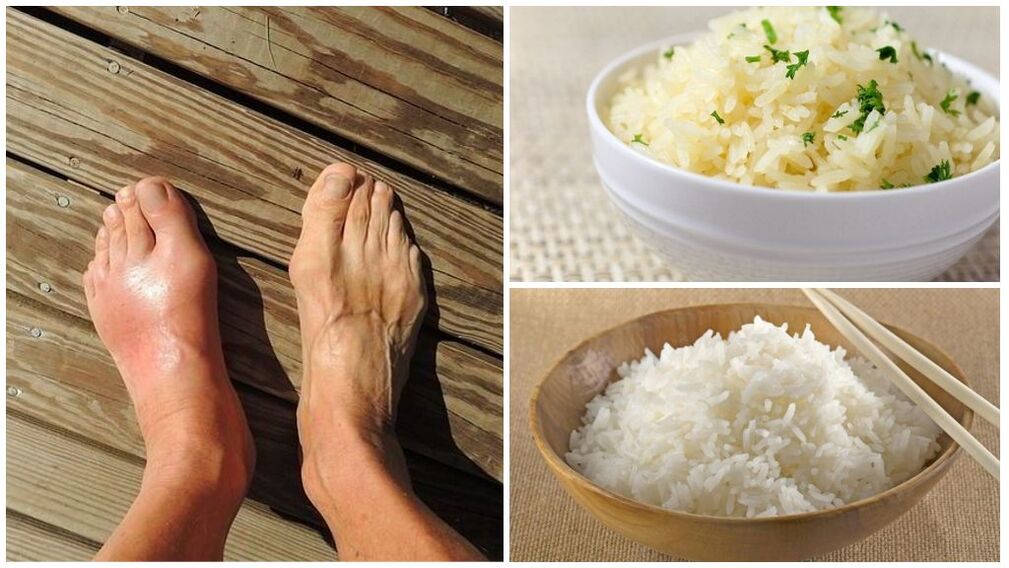
The porous structure of cereals removes the accumulated harmful toxins, salts and slag from the diseased joints. The rice diet can also be used on fasting days, especially during gout exacerbations.
Important!
Only brown or white steamed long grain rice is used in the diet. Dietary treatments for gout can be taken daily.
alkaline diet
Increased acidity in the body adversely affects metabolic processes. It is accompanied by a lack of calcium and the destruction of bone tissue. Using an alkaline diet will help prevent unhealthy processes. The diet is based on fruit, sour milk and dairy products. This diet can be used both during the exacerbation of gout and during the remission phase.
Prohibited and authorized products
In order to properly restore the nutritional system, it is necessary to know which foods will benefit and help in the fight against gout, and which of them will be harmful and cause exacerbation of the disease.
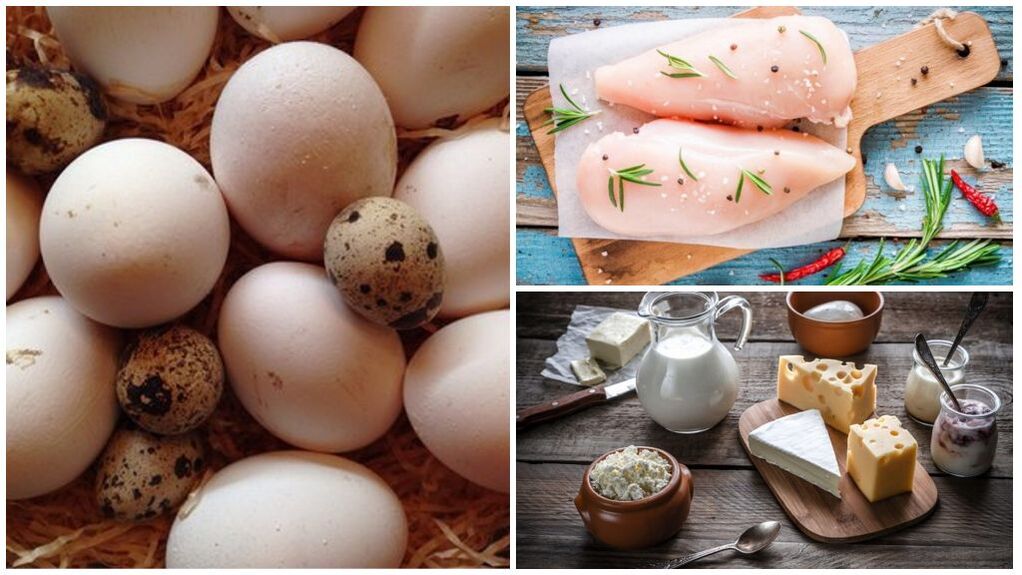
All foods can be listed in the table of essential nutrients for gout depending on the quantitative content of purines, salt, fat and other harmful substances. The main feature of the division of the list of gout products is the content of purine compounds.
| High purine content | Low purine |
|---|---|
|
|
Important!
In the case of gout, it is strictly forbidden to drink drinks that contain any amount of alcohol.
What products are useful
By measuring the levels of purines and unhealthy fats in foods, you can find out exactly which foods can be eaten with gout without harming your health and which should be limited.
On a note!
The group of products particularly useful in the treatment of gout includes pears, bananas and apples. Malic acid, which is part of the fruit, is able to neutralize the action of uric acid.
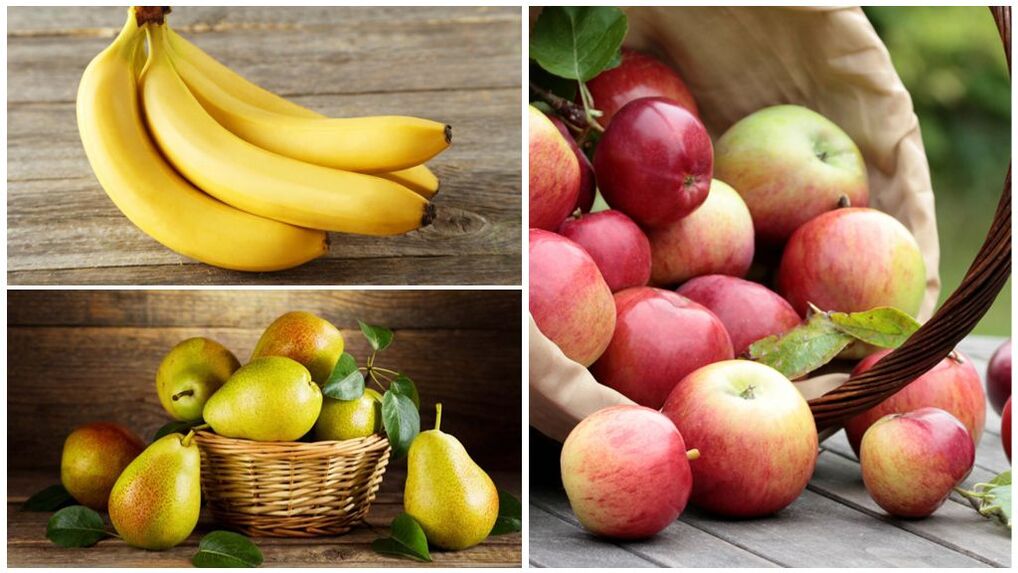
Potassium destroys uric acid crystals, which promotes its rapid elimination from the body. Ascorbic acid heals, regenerates and strengthens joint connective tissue. Fruit nutrition in fermented dairy products is especially useful.
Great benefits in case of gout will give regular consumption of fresh cherries and cherry compotes. The berries contain antioxidants that act against free radicals. Bioflavonoids and anthocyanins prevent the inflammatory process in gout.
The beneficial substances contained in strawberries and strawberries neutralize uric acid and prevent the formation of its crystals in the joints.
On a note!
You can include an unlimited amount of these berries and fruits in your gout diet.
What foods cannot be eaten
In addition to the products listed in the summary table, strong meat, fish and mushroom broths should be excluded from the diet. They are contraindicated because they have a high purine content, which can lead to a rapid exacerbation of gout. Unwanted and canned fish meat that contains a high percentage of salt. Taking them with a purine diet upsets the water and salt balance and promotes the deposition of extra salts in the joint tissue.
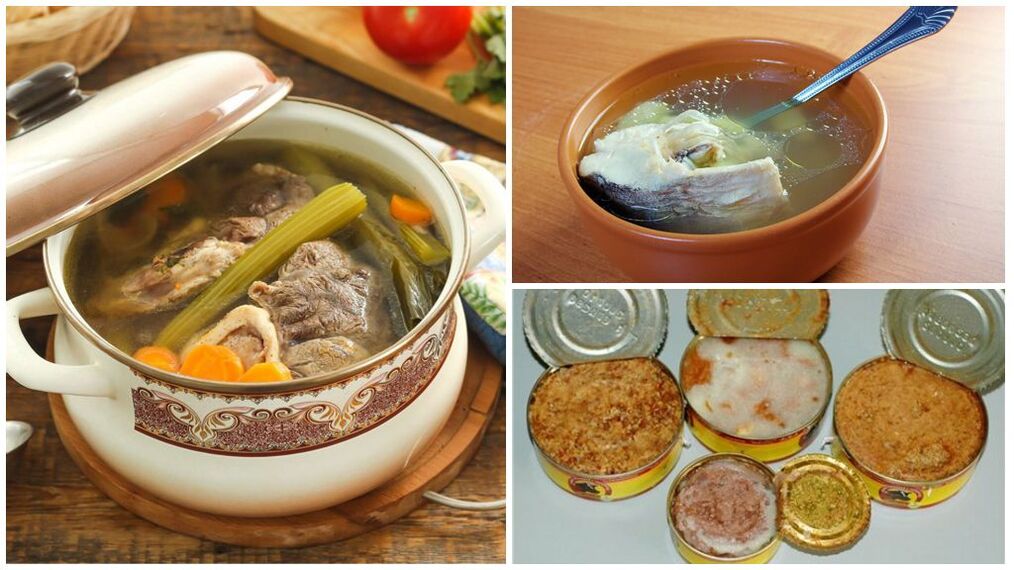
Gout also includes tea, coffee and cocoa in the list of banned foods. These drinks should not be drunk with gout, as they retain uric acid in the body, disrupting its excretion process. This leads to relapse.
Daily menu for the week
An extensive list of products allowed for consumption allows each patient with gout to approach their food choices and eat right. The recommended diet of the week is balanced, complete and consists of foods useful in the treatment of gout.
| Breakfast 1 | Omelette with greens, rosehip broth, carrot salad |
| Breakfast 2 | Banana, kefir |
| Dinner | Vegetable soup with vermicelli, boiled potatoes, rabbit in onion sauce, apple juice |
| afternoon tea | Apple, cheesecake, lemon tea |
| Dinner | Zucchini caviar, kissel |
| Breakfast 1 | Rice porridge, pear broth, tomato salad |
| Breakfast 2 | Fruit salad, kissel |
| Dinner | Onion soup, barley porridge with wild mushrooms, dried fruit compote |
| afternoon tea | Pear and pumpkin pans |
| Dinner | Cottage cheese souffle, linden tea |
| Breakfast 1 | Wheat porridge, apricot juice |
| Breakfast 2 | Yogurt with cherries, wild rose broth |
| Dinner | Soup with fish cutlets, vegetable stew, apple jelly |
| afternoon tea | Cheesecakes with sour cream and compote |
| Dinner | Pilaf with prunes, kefir |
| Breakfast 1 | Rice casserole, milkshake, cabbage salad with apple |
| Breakfast 2 | Strawberries with sour cream, green tea |
| Dinner | Beets with sour cream, buckwheat, turkey breast with prunes, mint tea |
| afternoon tea | Pancakes with strawberries, carrot juice |
| Dinner | Cheese casserole with greens, pear compote |

| Breakfast 1 | Oatmeal with raisins, tomato juice, fruit salad |
| Breakfast 2 | Cucumber salad with olive oil, orange juice |
| Dinner | Buckwheat soup, zucchini fried with rice, orange juice |
| afternoon tea | Banana, oatmeal jelly |
| Dinner | Steamed fish with vegetables, kefir |
| Breakfast 1 | Millet porridge, plum juice |
| Breakfast 2 | Salad with new carrots and garlic, as well as an apple |
| Dinner | Egg soup, cabbage rolls with vegetables and turkey, apple juice |
| afternoon tea | Cottage cheese with banana, strawberry tea |
| Dinner | Rice pudding, tomato juice |
| 1. breakfast | Boiled egg, green tea |
| 2. breakfast | Pear, green tea with marshmallows |
| Dinner | Borscht without meat, pasta and cheese, fruit compote |
| afternoon tea | Apples fried with cottage cheese, lemon drink |
| Dinner | Vinaigrette, decoction of linden |
Allowed vegetables and fruits can be used in unlimited quantities as a supplement to the main menu. Wheat bread is better not to use in patients with gout, including the thumb.
Important!
Foods with the addition of natural honey to gout can cause an allergic reaction.
Diet recipes
The sample weekly menu on offer includes many diet dishes tailored to what you should eat. If you want, you can replace them with others through a list of permitted foods for gout and suggestions on what you can and should not eat with gout.
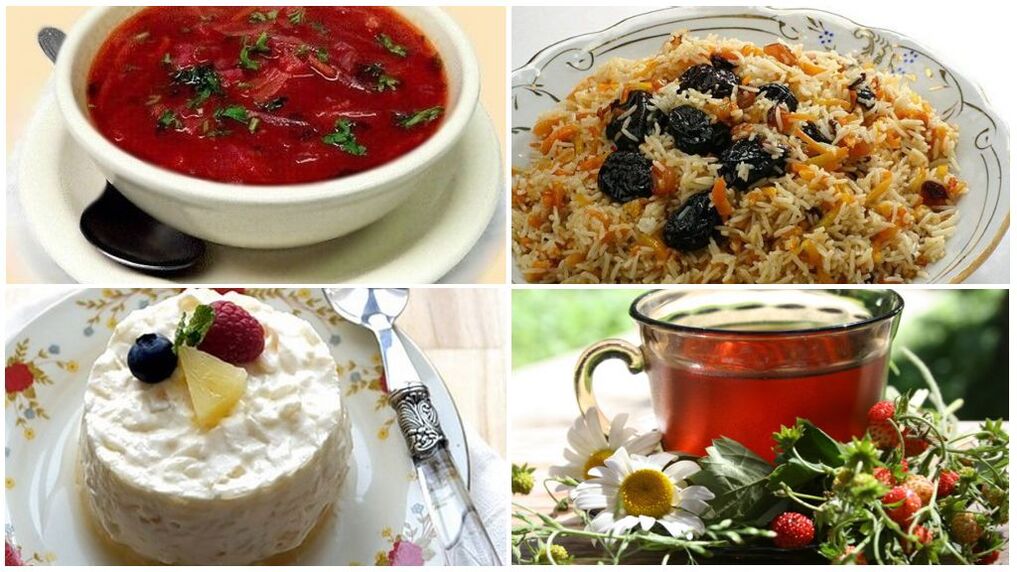
Borscht without meat
Peel 1 beet, carrot, onion. In olive oil sauté on a coarse grater grated diced onions and root vegetables, adding tomatoes or 1 tbsp. k. l. tomato. 4 potatoes cut into cubes, boil 1, 5 l of water. For 10 min. Add fresh cabbage cut into strips until ready. For 5 min. - Vegetable Stew. Taste with salt to taste. When serving, add parsley, dill and a spoonful of sour cream.
Pilaf with prunes
Rinse a glass of rice. In a saucepan with vegetable oil, add 2 onions cut into strips and 2 carrots cut into cubes. Stew everything a little. Add 10 pieces of washed and chopped prunes. Put everything until the vegetables are soft. Pour the rice, stir to make it completely saturated with oil, pour 2 cups boiling water. Add spices and salt to a minimum. After cooking, reduce heat and boil for 20 minutes under a tightly closed lid.
rice pudding
Boil half a cup of rice in 1 liter. water for 10 minutes. Drain the water, rinse the rice. Pour a glass of milk and cook for another 25 minutes. until soft porridge. Beat 2 eggs and steam 50 g of raisins. Mix everything with chilled porridge, add salt and 1 tsp to the end of the knife. Sahara. Bake in the oven over medium heat in a greased pan until golden brown. Serve with cherry syrup.
strawberry tea
Sprinkle a pinch of dry leaves with strawberries in a glass of boiling water, soak for 3 minutes. Drink without sugar.
By using these recipes every day, you can improve your well-being and reduce the manifestations of pathology.
Conclusion
Proper nutrition should make gout a daily norm in a patient's life. This will slow down or even stop the development of the pathology. As a result, it will be possible to protect other organs from damage.
Important!
It should be remembered that diet is a supplement, not a substitute for drug therapy. The recommendations of a rheumatologist should be followed at all stages of treatment.
















































































